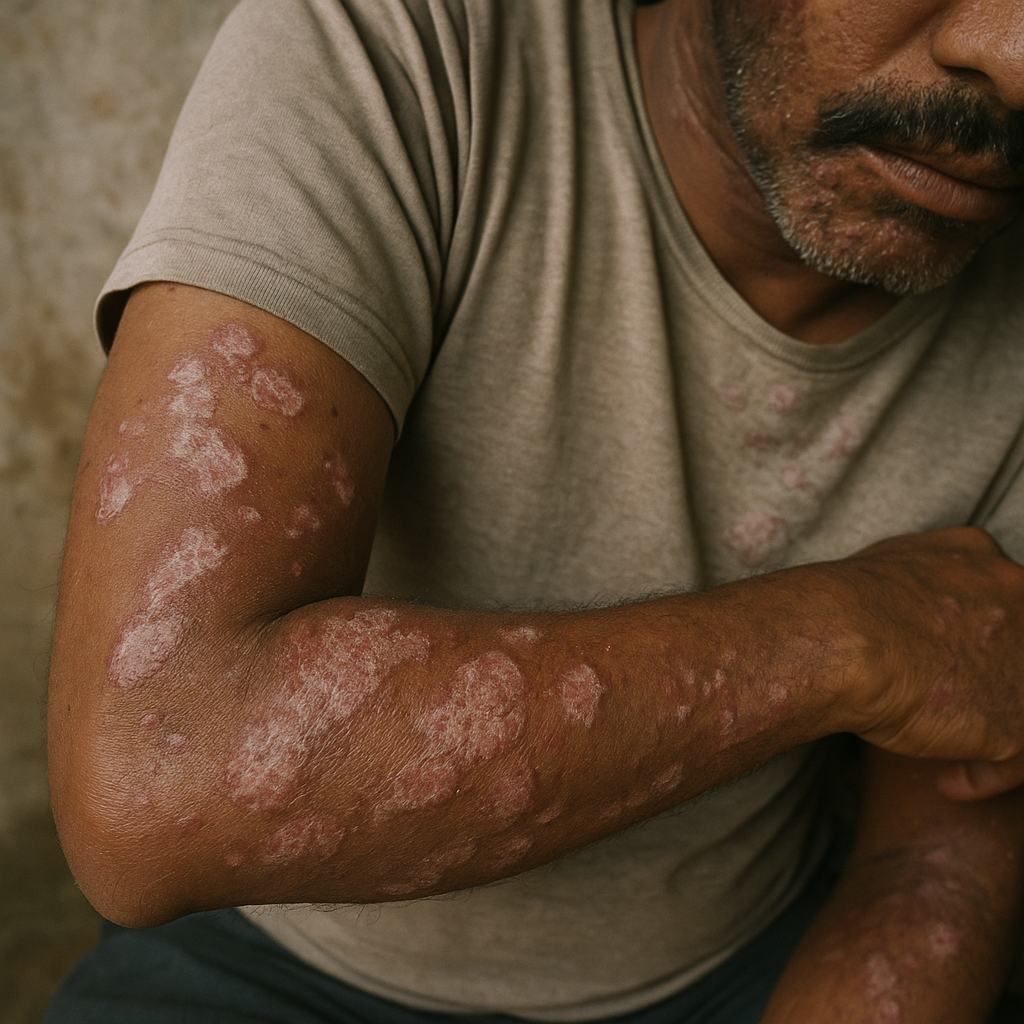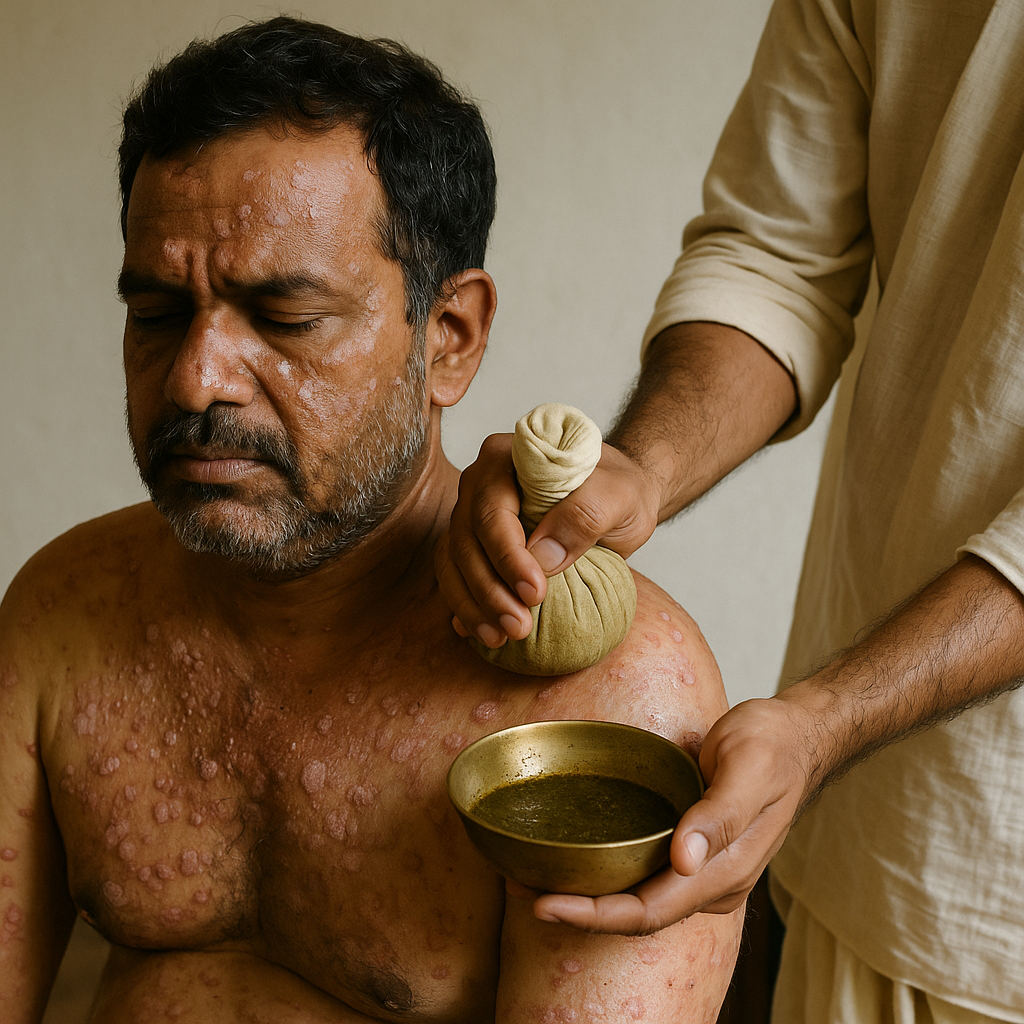आयुर्वेदिक डॉक्टर से प्रश्न पूछें और निःशुल्क या भुगतान मोड में अपनी चिंता की समस्या पर ऑनलाइन परामर्श प्राप्त करें। 2,000 से अधिक अनुभवी डॉक्टर हमारी साइट पर काम करते हैं और आपके प्रश्नों का इंतजार करते हैं और उपयोगकर्ताओं को उनकी स्वास्थ्य समस्याओं को हल करने में प्रतिदिन मदद करते हैं।
अभी हमारे स्टोर में खरीदें
What Is Kushta Roga in Ayurveda? Meaning, Symptoms, and Healing

If you’ve ever wondered what is Kushta Roga, or heard the term in a discussion about Ayurvedic skin disorders, you're not alone. In Ayurveda, a 5000-year-old system of natural healing from India, Kushta Roga refers to a group of skin diseases rooted in imbalances of the body's doshas — Vata, Pitta, and Kapha. Understanding Kushta Roga in Ayurveda isn’t just about defining an ancient disease category. It's about seeing the body as a whole, where skin issues are linked to digestion, lifestyle, and even mental health.
In this article, we’ll dig into what Kushta Roga actually is, how it shows up on the skin, the types of Kushta Roga (yes, there’s more than one!), and what Ayurvedic healing looks like. You'll also get practical insights, not just textbook definitions. Whether you’re dealing with chronic skin problems, or just curious, this guide is here to shed some honest light.
Let’s get into it.
Kushta Roga Meaning and Its Classification in Ayurveda
In simple terms, Kushta Roga means "skin disease" in Sanskrit — but that doesn’t capture the full picture. The word “Kushta” is derived from the root "Kushnati", meaning to destroy or distort. So, Kushta Roga implies something that disrupts or damages the skin and deeper tissues.
But in Ayurveda, Kushta Roga in English is more than just "skin disease". It’s seen as a reflection of inner health — imbalances that have surfaced on the skin. The skin, in this view, is like a mirror to the gut and blood health (rakta dhatu).
Kushta is traditionally classified into two main categories:
-
Maha Kushta (Major skin disorders)
-
Kshudra Kushta (Minor skin disorders)
This classification depends on severity, dosha involvement, and the depth of tissue damage. Ayurveda recognizes 18 types of Kushta Roga, which is pretty detailed, right?
Why so many? Because Ayurvedic science doesn't just slap on a label and move on. It looks at the individual's constitution (prakriti), habits, diet, and more. One person’s rash is not the same as another's eczema. That's the Ayurvedic vibe — deeply personalized healing.\

Kushta Roga Symptoms and How to Recognize Them
So, what does Kushta Roga actually look like?
Well, Kushta Roga symptoms can vary a lot, depending on which doshas are out of whack. But here are some common signs that might point to a Kushta-type skin condition:
-
Discoloration (white patches, red areas, darkening)
-
Scaling or dryness
-
Itching (sometimes mild, sometimes like... unbearable)
-
Oozing or pus-filled blisters
-
Cracks, thickening, or rough skin
-
Hair loss or nail changes in severe cases
You might have seen or experienced some of these and not known they could be part of a deeper imbalance. For example, chronic psoriasis or eczema? Those are often identified under skin Kushta Roga types in Ayurveda.
And sometimes the symptoms aren't just skin-deep. Some types of Kushta are also linked to digestive disturbances, fatigue, or even emotional imbalances. Remember, in Ayurveda, everything is connected.
Keep in mind: not every itchy patch is Kushta, but if it’s recurring, widespread, or hard to treat with modern creams alone... it might be time to explore the Ayurvedic lens.
Types of Kushta Roga
In Ayurveda, not all skin conditions are thrown into one basket. That’s where the concept of different kushta roga types comes in. The ancient texts identify 18 distinct forms of Kushta Roga, split between two broad categories: Maha Kushta (major) and Kshudra Kushta (minor).
These types aren’t just labeled by appearance — they’re categorized based on the involvement of doshas, tissue layers (dhatus), and severity. This deep classification helps Ayurvedic doctors tailor treatment in a far more nuanced way than just "take this cream and call me in the morning."
Let’s break it down.
Maha Kushta
Maha Kushta refers to the more serious and deep-rooted forms of skin diseases. These usually involve all three doshas (Vata, Pitta, and Kapha), and damage not only the outer skin but also deeper tissues.
Here are a few examples from the classical texts:
-
Kitibha: Dry, hard, thickened skin with itching. Sounds a bit like modern psoriasis.
-
Rakta Kushta: Linked to imbalances in the blood — this type is often associated with inflammation, redness, and burning sensations.
-
Siddma: White or pale patches that spread, often compared to vitiligo or leucoderma.
Maha Kushtas are persistent. They don’t respond well to surface-level treatments and need internal cleansing and lifestyle corrections.
One of the trickiest parts? They often come and go in cycles — looking healed one week, flaring up the next. This unpredictability is why Ayurvedic treatment for these conditions goes beyond topical care to cleanse at a deeper level.
Kshudra Kushta
On the other hand, Kshudra Kushta covers the less severe, more superficial skin issues. They may still cause discomfort or embarrassment, but they’re generally easier to treat and don’t cause extensive tissue damage.
Some examples include:
-
Dadru: Circular rashes with itching and mild redness, often equated to fungal infections like ringworm.
-
Pama: Tiny itchy eruptions, sometimes linked to eczema or allergic dermatitis.
-
Sataru Kushta: Slight scaling and dryness — more of a cosmetic nuisance than a health crisis.
But don’t be fooled. Just because it’s called “minor” doesn’t mean it’s always easy. Ignoring minor skin issues can cause them to evolve into deeper imbalances over time. What starts as a dry patch can turn into a recurring skin disorder if the root cause isn’t addressed.
That’s the thing with kushta roga in Ayurveda — the skin is like a messenger. When something inside is out of balance, it sends a signal. The trick is learning to understand and respond to that message, not just mute it with ointments.

Ayurvedic Treatment for Kushta Roga
Now that we’ve looked at what Kushta Roga is and its many faces, you’re probably wondering: how does Ayurveda treat it?
First off, Ayurvedic treatment doesn’t just attack the symptoms. It focuses on correcting the root imbalance, which is usually a combination of dietary, lifestyle, and environmental factors — and sometimes emotional stress too.
Here’s how kushta roga in Ayurveda treatment typically works:
-
Shodhana (Cleansing Therapies): This might include Panchakarma procedures like Vamana (therapeutic vomiting), Virechana (purgation), or Rakta Mokshana (bloodletting). Sounds intense? It can be — but also very effective in detoxifying the system.
-
Shamana (Pacification): Herbal medicines are given to calm the aggravated doshas. Ingredients like neem, turmeric, manjistha, and khadira are often used.
-
Diet & Lifestyle Adjustments: Patients are advised to avoid incompatible food combinations (like milk with salty food), fried stuff, fermented foods, and stress. Yes, stress — because your skin listens.
-
Topical Therapies: Oils like Mahamarichyadi Taila or herbal pastes are used, but always in combo with internal treatment.
Healing from skin kushta roga is a journey — not a quick fix. But for those who are tired of temporary relief and want lasting change, Ayurveda offers a complete approach.
Conclusion
So there you have it — a deep dive into the world of Kushta Roga in Ayurveda, an area that goes far beyond what meets the eye (or skin). From understanding what is Kushta Roga to exploring its symptoms, types, and treatments, it becomes clear that Ayurveda sees skin disorders as more than just surface-level issues.
The beauty of the Ayurvedic approach? It's holistic. It doesn’t just patch up your symptoms; it tries to heal the root cause, whether that's sluggish digestion, poor food habits, chronic stress, or all of the above.
And while the modern world leans heavily on steroid creams and antibiotics (which can sometimes work temporarily), kushta roga in Ayurveda treatment offers a sustainable way forward. It’s slower, sure, but it's like nurturing a plant from its roots, not just painting the leaves green.
Of course, Ayurveda isn’t magic. You’ll need patience, discipline, and guidance from a qualified practitioner. But for many who've struggled for years with recurring skin issues, it’s been a total game-changer.
Maybe even life-changing.
Don’t expect overnight miracles — but do expect a shift if you're consistent. And who knows, maybe that chronic itch or flaky patch isn’t just a random inconvenience. Maybe it’s your body’s way of asking for deeper healing.
FAQs
What is Kushta Roga in English?
In English, Kushta Roga is commonly translated as "skin disease," but this doesn’t quite cover the full Ayurvedic meaning. It refers to a wide range of skin conditions caused by doshic imbalances, and includes everything from minor rashes to serious, chronic skin disorders.
So yeah, it’s more than just a rash or acne breakout.
Are all skin diseases considered Kushta in Ayurveda?
Not exactly. While many skin diseases fall under the kushta roga umbrella, Ayurveda differentiates between those that are caused by doshic imbalances (true Kushta) and others triggered by external factors or temporary reactions. The depth of tissue involvement and chronicity also matter.
In short: many skin issues = Kushta Roga, but not all of them.
How long does Ayurvedic treatment for Kushta take?
Whew — this one's a bit tricky. The timeline depends on several things:
-
The type of Kushta Roga (is it Maha or Kshudra?)
-
How long you’ve had it
-
Your body constitution (prakriti)
-
Your willingness to follow the treatment plan
Some people see improvement in a few weeks. Others may need several months or even longer for deep-rooted skin Kushta Roga types. And sometimes symptoms flare before they settle — it's not always a straight line.
That said, the goal isn't just to feel better. It's to fix the system that created the issue in the first place.
Final Thoughts
Skin problems can seriously mess with your confidence, comfort, and even your relationships. But they don’t have to be a life sentence. With the right understanding — and the right path — healing is possible. Ayurveda’s wisdom around Kushta Roga gives us not just tools, but a new way to see our health. One that’s kinder, smarter, and more in tune with nature.
If you’ve been struggling with skin issues that won’t go away, maybe it’s time to look deeper. Explore an Ayurvedic consult. Start small — cut one aggravating food from your diet. Or just share this article with someone who needs it.
They might just thank you for it.
यह लेख वर्तमान योग्य विशेषज्ञों द्वारा जाँचा गया है Dr Sujal Patil और इसे साइट के उपयोगकर्ताओं के लिए सूचना का एक विश्वसनीय स्रोत माना जा सकता है।

